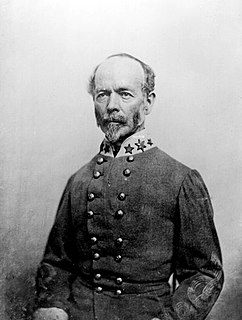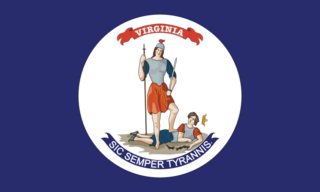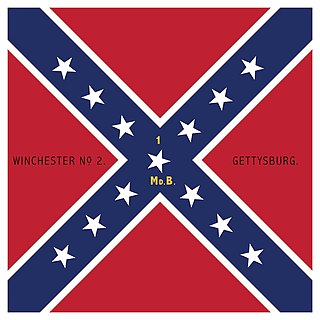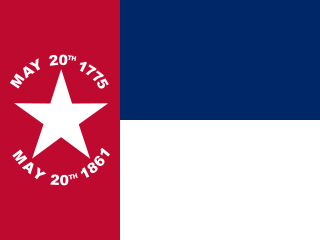
The Army of Northern Virginia was the primary military force of the Confederate States of America in the Eastern Theater of the American Civil War. It was also the primary command structure of the Department of Northern Virginia. It was most often arrayed against the Union Army of the Potomac.

The Battle of New Market was fought on May 15, 1864, in Virginia during the Valley Campaigns of 1864 in the American Civil War. A makeshift Confederate army of 4,100 men defeated the larger Army of the Shenandoah under Major General Franz Sigel, delaying the capture of Staunton by several weeks.
The Battle of McDowell, also known as the Battle of Sitlington's Hill, was fought on May 8, 1862, near McDowell, Virginia, as part of Confederate Major General Stonewall Jackson's 1862 Shenandoah Valley campaign during the American Civil War. After suffering a tactical defeat at the First Battle of Kernstown, Jackson withdrew to the southern Shenandoah Valley. Union forces commanded by Brigadier Generals Robert Milroy and Robert C. Schenck were advancing from what is now West Virginia towards the Shenandoah Valley. After being reinforced by troops commanded by Brigadier General Edward Johnson, Jackson advanced towards Milroy and Schenck's encampment at McDowell. Jackson quickly took the prominent heights of Sitlington's Hill, and Union attempts to recapture the hill failed. The Union forces retreated that night, and Jackson pursued, only to return to McDowell on 13 May. After McDowell, Jackson defeated Union forces at several other battles during his Valley campaign.

The Battle of Cloyd's Mountain was a Union victory in western Virginia on May 9, 1864, that allowed the Union forces to destroy a large bridge on the Virginia and Tennessee Railroad. The railroad was used to carry Confederate troops and supplies, and served important lead and salt mines. It also helped connect the Confederate capital of Richmond with Tennessee, and had telegraph wires along its line for communications. The fight had a high percentage of casualties for both sides, and the Confederate commander, Brigadier General Albert G. Jenkins, was mortally wounded.
The Stonewall Brigade of the Confederate Army during the American Civil War, was a famous combat unit in United States military history. It was trained and first led by General Thomas J. "Stonewall" Jackson, a professor from Virginia Military Institute (VMI). His severe training program and ascetic standards of military discipline turned enthusiastic but raw recruits into an effective military organization, which distinguished itself from the First Battle of Bull Run in 1861 to Spotsylvania Court House in 1864. Its legacy lives on in the 116th Infantry Brigade, which bears the unofficial nickname "Stonewall Brigade," and in several living history reenactment groups.

The Army of the Shenandoah was an army of the Confederate States of America during the American Civil War; it was organized to defend the Shenandoah Valley of Virginia in the early months of the war. The army was transferred to reinforce the Confederate Army of the Potomac at the First Battle of Bull Run, which was its only major action. After the battle, the army was merged into the Army of the Potomac.

The Battle of Droop Mountain occurred in Pocahontas County, West Virginia, on November 6, 1863, during the American Civil War. A Union brigade commanded by Brigadier General William W. Averell defeated a smaller Confederate force commanded by Brigadier General John Echols and Colonel William L. "Mudwall" Jackson. Confederate forces were driven from their breastworks on Droop Mountain, losing weapons and equipment. They escaped southward through Lewisburg, West Virginia; hours before a second Union force commanded by Brigadier General Alfred N. Duffié occupied the town.
The 9th West Virginia Infantry Regiment was an infantry regiment that served in the Union Army during the American Civil War.

The 2nd West Virginia Cavalry Regiment served in the Union Army during the American Civil War. It was organized in Parkersburg, Virginia during September 1861. Most of the original members of this regiment were from southeastern Ohio, and planners thought that this regiment would become the 4th Ohio Cavalry. Their application was rejected by the governor of Ohio, so the unit became the 2nd Regiment of Loyal Virginia Volunteer Cavalry. The "Loyal Virginia" part of the name was replaced with "West Virginia" after the state of West Virginia was officially admitted to the Union in 1863. Today, the National Park Service lists them as 2nd Regiment, West Virginia Cavalry under a heading of Union West Virginia Volunteers.

The 3rd West Virginia Cavalry Regiment was a cavalry regiment that served in the Union Army during the American Civil War. In 1864, the regiment had an important part in the Battle of Moorefield, where a surprise attack led by General William W. Averell routed Confederate cavalry. The regiment also fought in the latter part of General Philip H. Sheridan's Valley Campaign, and was part of Capehart's Fighting Brigade in General George Armstrong Custer's Third Division. It was present at General Robert E. Lee's surrender of the Army of Northern Virginia at the Battle of Appomattox Court House.

The 35th Virginia Cavalry Battalion, also known as White's Battalion, White's Rebels and the Comanches, was a Confederate cavalry unit during the American Civil War raised by Elijah V. White in Loudoun County, Virginia in the winter of 1861-62. The battalion was initially raised as border guards along the Potomac River below Harpers Ferry but were ultimately mustered into regular service as part of the Laurel Brigade. Despite this, they continued to play a conspicuous role in the ongoing partisan warfare in Loudoun throughout the war. The battalion was particularly notable during the 1863 Gettysburg Campaign, when it played a prominent role in the Battle of Brandy Station and subsequently conducted a series of raids on Union-held railroads and defensive positions in Maryland and Pennsylvania. The 35th was the first Confederate unit to enter Gettysburg, Pennsylvania.

The 7th Virginia Cavalry Regiment also known as Ashby's Cavalry was a Confederate cavalry regiment raised in the spring of 1861 by Colonel Angus William McDonald The regiment was composed primarily of men from the counties of the Shenandoah Valley as well as from the counties of Fauquier and Loudoun. Two companies contained men from the border counties of Maryland.

The 25th Virginia Infantry Regiment was an infantry regiment raised in Virginia for service in the Confederate States Army during the American Civil War. It fought mostly with the Army of the Northwest and Army of Northern Virginia. Its soldiers saw action from the battle of Philippi until the Appomattox.

The 11th Virginia Cavalry Regiment was a cavalry regiment raised in Virginia for service in the Confederate States Army during the American Civil War. It fought mostly with the Army of Northern Virginia.

The 17th Virginia Cavalry Regiment was a cavalry regiment raised in Virginia for service in the Confederate States Army during the American Civil War. It fought with the Army of Northern Virginia, in southwestern Virginia, and in the Shenandoah Valley.

The 2nd Maryland Infantry, CSA, was a Confederate infantry regiment made up of volunteers from Maryland who, despite their home state remaining loyal to the Union during the American Civil War, chose instead to fight for the Confederacy. The regiment was largely made up of volunteers from the 1st Maryland Infantry, CSA, which was disbanded in August 1862, its initial term of duty having expired. They saw action at many of the fiercest battles of the Civil War, taking part in the brutal fighting at Culp's Hill at the Battle of Gettysburg. The unit suffered such severe casualties during the war that, by the time of General Robert E. Lee's surrender at Appomattox Court House on April 9, 1865, only around forty men remained.
The 1st Connecticut Cavalry Regiment was a cavalry regiment that served in the Union Army during the American Civil War.

The 20th North Carolina Infantry Regiment was an infantry regiment in the Confederate States Army. It was part of the Army of Northern Virginia for most of the war.

William Henry Powell was an American soldier who fought for the Union in the American Civil War. He was a leader in the iron and nail business before the war, and his leadership abilities proved useful in the military. Powell began as a captain, and quickly ascended to higher roles in the cavalry, including commanding a regiment, a brigade, and then a division. Powell was awarded his country's highest award for bravery during combat, the Medal of Honor, for heroism at Sinking Creek, Virginia, when, as leader of a group of 22 men, he captured an enemy camp and took over 100 prisoners. This was accomplished without the loss of any of his men on November 26, 1862. He was honored with the award on July 22, 1890.

The 18th Pennsylvania Cavalry Regiment was a cavalry regiment of the Union Army during the American Civil War. The regiment was present for 50 battles, beginning with the Battle of Hanover in Pennsylvania on June 30, 1863, and ending with a skirmish at Rude's Hill in Virginia during March 1865. A majority of its fighting was in Virginia, although its first major battle was in Pennsylvania's Gettysburg campaign. It was consolidated with the 22nd Pennsylvania Cavalry Regiment on June 24, 1865, to form the 3rd Provisional Pennsylvania Cavalry Regiment.












